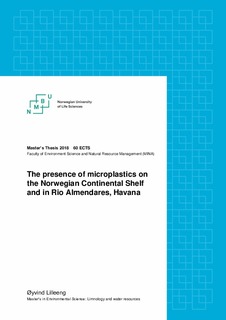| dc.contributor.advisor | Almås, Åsgeir R. | |
| dc.contributor.advisor | Arp, Hans Peter | |
| dc.contributor.author | Lilleeng, Øyvind | |
| dc.date.accessioned | 2018-10-30T09:52:08Z | |
| dc.date.available | 2018-10-30T09:52:08Z | |
| dc.date.issued | 2018 | |
| dc.identifier.uri | http://hdl.handle.net/11250/2570085 | |
| dc.description | Quantification and identification of microplastic using density separation and FTIR analysis | nb_NO |
| dc.description.abstract | Microplastics are becoming more frequently detected in all natural environments worldwide as global demand for plastic production continues to rise and studies related to microplastic research are becoming more prevalent. Marine sediments are hypothesized by many researchers to be a major sink for microplastics as they will sink to the ocean floor over time due to size and density modifications in open waters. Microplastic research has become a stimulated topic receiving increasing attention globally. To this date, there is no standard analytical protocol for microplastic quantifications and identification, leading to dissimilarities in methods and less comparability between studies.
This thesis investigates two separate benthic sediments, one being deep-sea sediments from the Norwegian Continental Shelf and the other river sediment from Rio Almendares (Cuba). Sediment samples were investigated for microplastic using density separation, purification, and polymer identifications practicing both visual analysis and FTIR analysis. | nb_NO |
| dc.description.abstract | Mikroplast i naturen blir i økende grad påvist i stadig flere miljøtyper ettersom den globale etterspørselen etter plast fortsetter å stige, og studier relatert til mikroplastforskning blir stadig mer utbredte. Enkelte forskere mener at havbunnen utgjør et reservoar for akkumulert mikroplast. Gjennom biologiske-, kjemiske- og mekaniske prosesser i marine omgivelser vil plastpartikler gjennomgå størrelses- og tetthetsendringer, noe som igjen kan føre til at mikroplast sedimenterer til havbunnen. Forskning på mikroplast er for tiden et høyrelevant tema som i økende grad får oppmerksomhet på et globalt nivå. Per dags dato finnes det ingen standardisert analytisk protokoll for kvantifisering og identifisering av mikroplast i havsedimenter. Store metodiske forskjeller innad i forskningsmiljøene påvirker blant annet sammenlignbarheten av resultatene på tvers av studier, noe som gjør det vanskelig å påvise en signifikante forskjell.
Denne oppgaven undersøker to ulike typer sedimenter; et utvalg av dybhavsliggende sediment fra norsk kontinentalsokkel (NCS) og elvesedimenter fra Rio Almendares (Cuba). Sedimentprøvene ble undersøkt for mikroplast ved bruk av tetthetsseparasjon, kjemisk nedbrytning av organisk materiale og identifisering ved hjelp av både visuell analyse og FTIR-analyse. | nb_NO |
| dc.description.sponsorship | NGI ; WEATHER-MIC: JPI Oceans | nb_NO |
| dc.language.iso | eng | nb_NO |
| dc.publisher | Norwegian University of Life Sciences, Ås | nb_NO |
| dc.rights | Navngivelse 4.0 Internasjonal | * |
| dc.rights.uri | http://creativecommons.org/licenses/by/4.0/deed.no | * |
| dc.subject | FTIR | nb_NO |
| dc.subject | The Norwegian Continental Shelf | nb_NO |
| dc.subject | Rio Almendares | nb_NO |
| dc.subject | Havana | nb_NO |
| dc.subject | Cuba | nb_NO |
| dc.subject | Norway | nb_NO |
| dc.subject | Rivers | nb_NO |
| dc.subject | Sedimenter | nb_NO |
| dc.subject | Sediments | nb_NO |
| dc.subject | Polymers | nb_NO |
| dc.title | The presence of microplastics on the Norwegian Continental Shelf and in Rio Almendares, Havana | nb_NO |
| dc.type | Master thesis | nb_NO |
| dc.description.version | submittedVersion | nb_NO |
| dc.source.pagenumber | 54 | nb_NO |
| dc.description.localcode | M-MINA | nb_NO |

